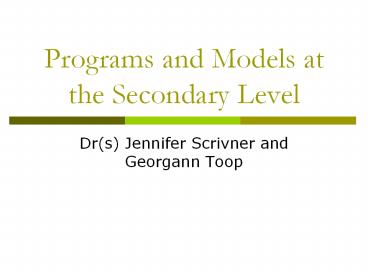Programs and Models at the Secondary Level PowerPoint PPT Presentation
1 / 8
Title: Programs and Models at the Secondary Level
1
Programs and Models at the Secondary Level
- Dr(s) Jennifer Scrivner and Georgann Toop
2
Middle School Years
- Conflicting educational goals, values and
philosophies of specialist in gifted education
and middle school specialist. - Cooperative Learning proponents have complicated
the issues within the middle school movement
3
Lets look at the research
- Rosselli (1990) analyzed tenets of the MS
movement.she concluded that a number of tenets
in the movement can be used as guides to sound
practice with the gifted. (8 of 37 are
commensurate with Gifted Ed) - Nongraded approach, encouragement of creativity,
specific opportunities for gifted exploratory
study differentiation emphasis in problem
solving progression according to student ability
4
Gallagher, Coleman, and Nelson (1995)
- Surveyed 317 middle schools on views concerning
cooperative learning and gifted education. They
found considerable disagreement among advocates
and strong indications of little collaboration
between groups. The major areas of disagreement
were ability grouping and labeling children as
gifted. The teacher in this study expressed
particular concern with the lack of challenge
with cooperative learning and the use of gifted
students as jr teachers and the lack of
opportunity for students to work with advanced
content.
5
Tomlinson (1995)
- Intensive, qualitative study of one middle school
program. She found that many teachers simply did
not know how to differentiate the curriculum and
instruction to meet the needs of talented youth
not did they know how to challenge them at a
level commensurate with their potential.
Management of DI was a particular challenge for
teachers who were used to suing a common lesson
plan and text for all students, regardless of
student diversity. The need to intensive staff
development for MS teachers was indicated in the
study.
6
Coleman (1995)
- NMSA and NAGC meet to delineate a shared
philosophy - Allow each student to work at his/her own pace
and level of learning - Use team teaching and planning
- Use exploratory curriculum in class
- Develop interdisciplinary curricula
- Emphasize thinking skills and decision making in
the curriculum - Develop teams or families within large MS
- Have teacher become more facilitators of learning
than disseminators of knowledge - Extend learning beyond the textbook
7
High School Programs
- All models call for
- Accelerated learning experiences
- Special advanced classes
- Early admission classes
- Extracurricular activities related to student
interest - Extended learning opportunities in academic,
artistic and athletic domains
8
High School Program Options
- Counseling services for career
- Advanced Placement classes (9-12) for top 10 of
students - Honors Classes
- English
- Social Studies
- Biology
- Seminars
- Foreign Language
- International Baccalaureate
- Dual enrollment
- Acceleration
- Begin algebra at gr 7
- Enroll in english/social studies early

